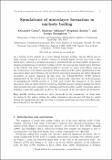Simulations of microlayer formation in nucleate boiling
Author(s)
Guion, Alexandre Nicolas; Zaleski, Stéphane; Buongiorno, Jacopo
DownloadAccepted version (1.243Mb)
Publisher with Creative Commons License
Publisher with Creative Commons License
Creative Commons Attribution
Terms of use
Metadata
Show full item recordAbstract
As a bubble grows outside of a cavity during nucleate boiling, viscous effects can be large enough compared to surface tension to impede liquid motion and trap a thin liquid layer, referred to as the microlayer, underneath the growing bubble. Numerical simulations of nucleate boiling typically resolve the macroscopic liquid-vapor interface of the bubble, but resort to subgrid models to account for micro scale effects, such as the evaporation of the microlayer. Evaporation models require initialization of the microlayer shape and extension, but models for microlayer formation are either physically incomplete or purely empirical. In this work, the Volume-Of-Fluid (VOF) method, implemented in the Gerris code, is used to numerically reproduce the hydrodynamics of hemispherical bubble growth at the wall, and resolve the formation of the microlayer with an unprecedented resolution. The simulations are validated against the latest experimental data and compared to existing analytical models. Lastly, remaining gaps in building a generally applicable model for the formation of the microlayer are presented.
Date issued
2018-12Department
Massachusetts Institute of Technology. Department of Nuclear Science and EngineeringJournal
International Journal of Heat and Mass Transfer
Publisher
Elsevier BV
Citation
Guion, Alexandre, Shahriar Afkhami, Stéphane Zaleski, and Jacopo Buongiornoa. "Simulations of microlayer formation in nucleate boiling." International Journal of Heat and Mass Transfer 127 (2018): 1271-1284 © 2018 The Author(s)
Version: Author's final manuscript
ISSN
0017-9310
Keywords
Mechanical Engineering, Condensed Matter Physics, Fluid Flow and Transfer Processes